If you’re looking for first-class inshore angling action, look no further than Trinity Bay. This gem is located in the very heart of Texas’s Gulf Coast and is home to the world-famous Inshore Grand Slam trio: Redfish, Speckled Trout, and Flounder. There’s no dilemma about it – fishing in Trinity Bay’s shallows is a dream come true for every passionate fisherman.

Cozily nestled between Galveston Bay and Trinity River, this 20-mile-long bay boasts incredible angling grounds. Be it bayous, flats, or marshes, Trinity Bay is an inshore heaven. And with prolific fisheries under its belt, fishing in Trinity Bay can be nothing but fulfilling. But how should you go about your Trinity Bay angling adventure?
This is what we’ll cover in the following article. We’ll give you more information on the fish species, angling approaches, hotspots, and regulations for these waters. So, without further ado, let’s see what Trinity Bay has to offer.
What kind of fish are in Trinity Bay?
We already mentioned the Inshore Grand Slam trio. Naturally, we’ll dedicate more time and space to them. But Redfish, Speckled Trout, and Flounder aren’t the only superstars living in these waters. Read on to find out more about Trinity Bay’s celebrities.
Redfish
No fish is as famous in Texas as Redfish. Red Drum – more commonly known as Redfish around here – are battle-worthy, brag-worthy, and meal-worthy catches. They check all the qualities of an excellent game fish. There’s no wonder they’re on everyone’s must-fish list! Even if you aren’t after an Inshore Grand Slam, you can’t leave Trinity Bay without scoring a picture-perfect Red.

Luckily, Trinity Bay is brimming with these divine-looking creatures year-round. Some seasons such as late summer and early fall are more productive than others, but Redfish fishing in Trinity Bay remains decent throughout the entire year. So, you don’t have to spend too much time figuring out the dates for your Trinity Bay visit.
The same goes for your angling approach – don’t overthink it. Redfish are susceptible to a variety of lures and fishing methods. They aren’t picky and you can prove that by experimenting with shrimps, crabs, spoons, plastic lures, and jigheads. They’ll also fall for wading, fly fishing, surf angling, sight, or blind casting.
But what you should be aware of is that they won’t go down without a fight. So, mix and match until you find your winning combo. Just remember that Reds will make you break a sweat.
Speckled Trout
If you’ve laid your hands on an impressive Redfish specimen, why stop there? Keep on fishing until you hit the Inshore Grand Slam! And the next fish that brings you closer to that goal is Speckled Trout. Now let’s see how you can outsmart these beauties when fishing in Trinity Bay.
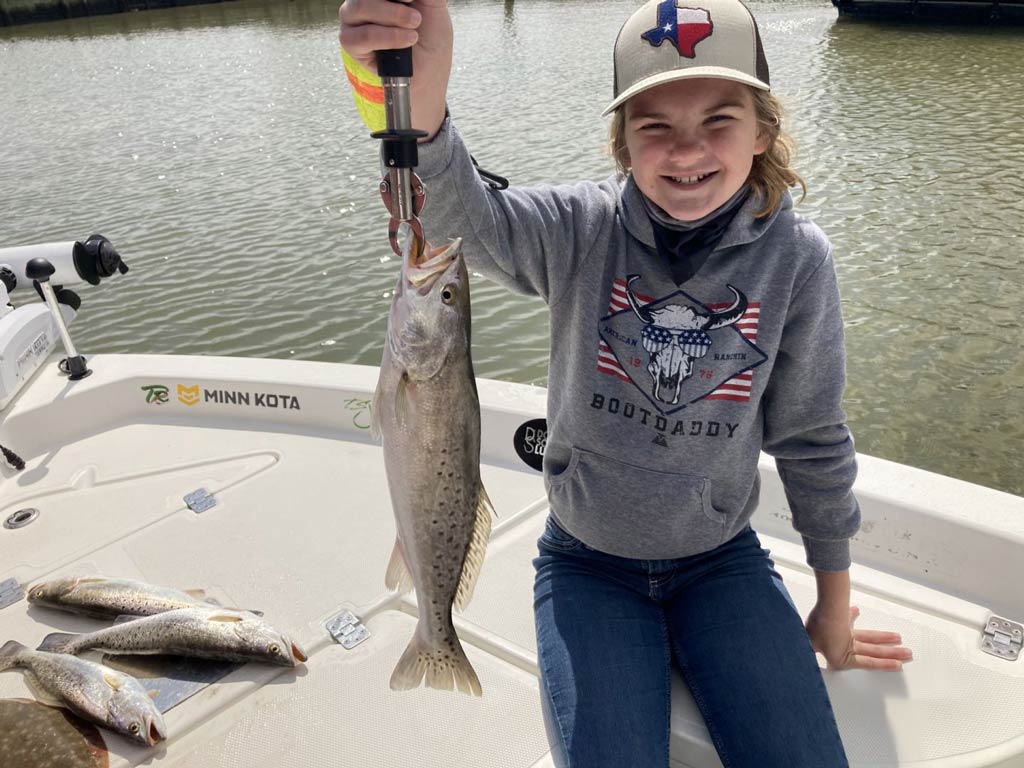
The best bait for attracting Specks is live shrimp. You can also use mullet, but shrimp is their kryptonite. Surface poppers seem to be working as well. As for the angling approach, wading and drifting are the most popular ways of getting hold of Speckled Trout. Both are equally effective as they don’t spook the fish.
Specks will grace the end of your line, it only comes down to what bait and method you prefer. But don’t forget about the timing, either. While you may see them swimming around throughout the year, your hunt will be more successful during spring and fall. What’s more, Specks thrive in October. So, align your visit with their favorite month, and you won’t end up empty-handed.
Flounder
If you outsmart Reds and Specks, there’s no way back. You have to unlock the Inshore Grand Slam and proceed with catching Flounder, too. Unlike their fellow residents – Redfish and Speckled Trout, Flounder are primarily bottom fish. This means that their eating habits differ from how Reds and Specks normally feed. In turn, your angling approach will vary slightly, too.

Flounder inhabit the seafloor around different structures such as pilings, bridges, and jetties in search of food. While you can intrigue them with small shrimps, they won’t be able to resist mullet and mud minnows. Use sinkers to lower your bait, but don’t forget to move them so that Flounder can notice the prey and attack it.
As for when to target them, you’ve probably guessed it – October is your ally. Flounder are plentiful in fall, but Trinity Bay doesn’t lack them in spring and summer either.
Sheepshead
While not as wanted as their Inshore Grand Slam friends, Sheepshead are far from being a boring fish. They’re probably the most interesting inshore species in Trinity Bay. Their looks alone are the perfect conversation starter. To be more precise, their human-like teeth and prison uniform-like stripes are an endless source of speculation.
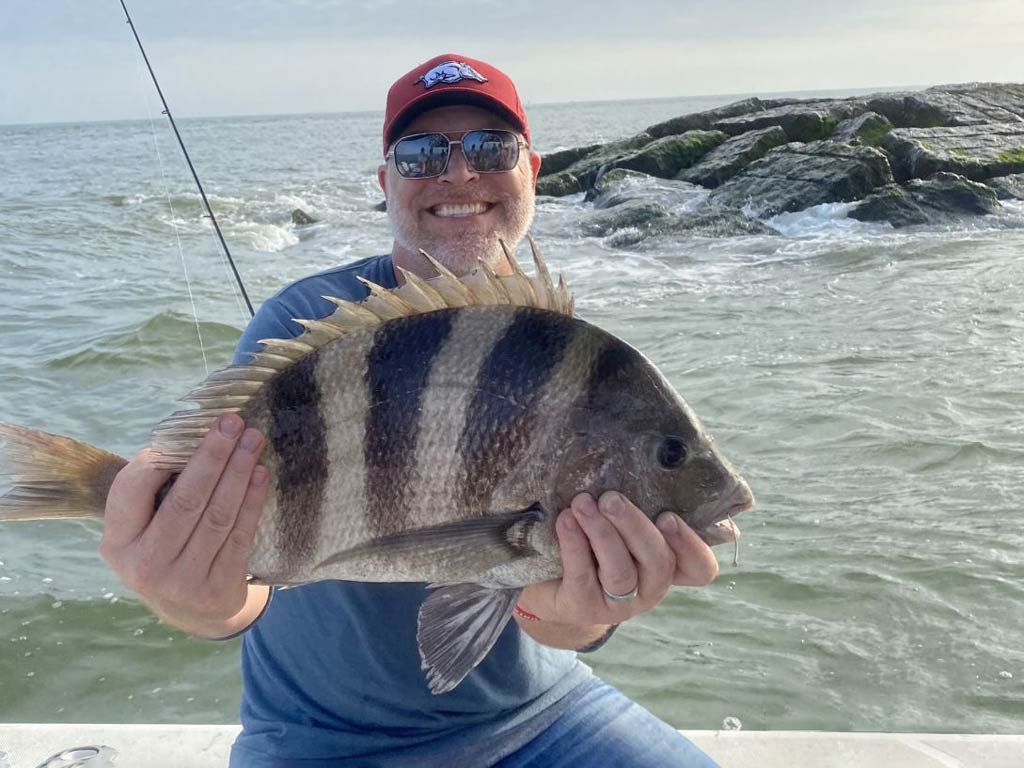
But that’s not all that’s fascinating. Apart from being a real Halloween-inspired catch, Sheepshead are surprisingly fast and sly. They’ll sneak up on your bait and storm away with it without you even noticing what happened. But don’t let this discourage you from pursuing them. Bottom fishing with clams or crabs around jetties is the name of the game. And staying alert, of course!
… And More!
Redfish, Speckled Trout, Flounder, and Sheepshead rule the inshore waters here. However, fishing in Trinity Bay is much more than its headliners. You can visit the area any time of the year and you won’t end up empty-handed. Apart from Red Drums, you can always count on Black Drums to meander the Texan coastline.

You can cross paths with Sharks and Mackerel, too. Don’t be surprised if you occasionally stumble on Mangrove Snappers as well. All in all, you get the picture – Trinity Bay has a lot to offer. From eerie-looking fish to awe-inspiring combatants, fishing in Trinity Bay won’t disappoint. Now that you know who your opponents are, let’s see what are the best ways to catch them.
How to Go Fishing in Trinity Bay
Due to its tucked-away position, you can explore the bay both on foot and aboard different vessels. Each approach has its own advantages and the choice is entirely up to you. We’ll outline a couple of ways to fish in Trinity Bay below to help you choose.
Charter Fishing
When in doubt, team up with Trinity Bay fishing charter operators. These guys have most likely been fishing in Trinity Bay their entire lives. This means they’re familiar with the weather, water, and angling conditions in the bay. They’re knowledgeable and they specialize in the Inshore Grand Slam hunts. So, who better than them to show you around?
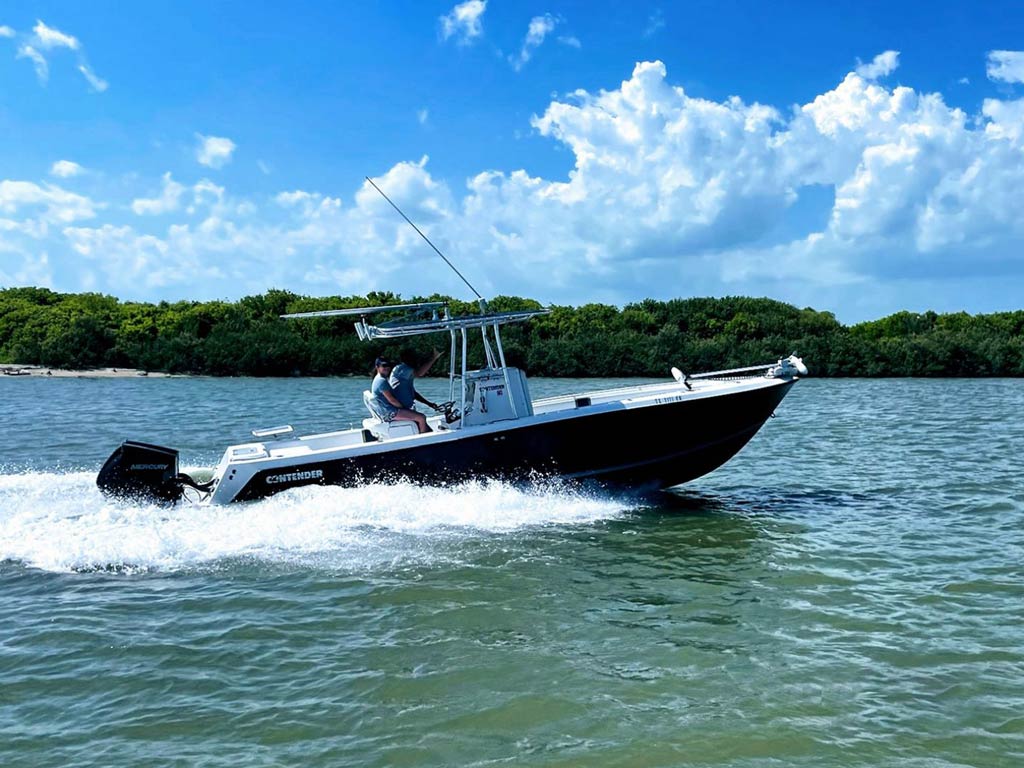
Apart from their skills, Trinity Bay guides provide top-notch boats and equipment. You’ll mostly be drifting or bottom fishing but, depending on the fish and your preferences, you can always agree with your captain to try out different angling approaches.
And remember, even if you’ve fished for Red Drum before, it doesn’t mean that Reds in Trinity Bay will behave in the same way as Redfish elsewhere. For this reason alone, local insight is invaluable. So, charter fishing isn’t only for first-timers, but everyone who’d like to get the most out of the area.
Kayak Fishing
Unlike charter angling, kayak fishing is usually reserved for more experienced fishermen. Kayak fishing requires not only casting and reeling expertise but also maneuvering skills. It may be difficult for someone who has neither fished nor kayaked before to do them both for the first time. So, if you’d like to practice kayak fishing, pair up with an experienced angler or guide.

Trinity Bay is perfect for kayak fishing. The waters are calm on the surface but teeming with life underneath it. Plus, kayak fishing is ideal for targeting inshore species that are easily spooked. It gives you the opportunity to reach them without scaring them away. And on top of everything else you get to enjoy the view and explore it at your own pace.
Shore Fishing
If you’d rather stay closer to the shoreline, don’t worry. Trinity Bay offers great options for shore anglers, too! There are numerous jetties and beaches from which you can cast your line and end up with a good catch. Don’t forget that many fish species come close to the shore in search of food. So, you’ll be in for a treat even if you stay dry at the dock.
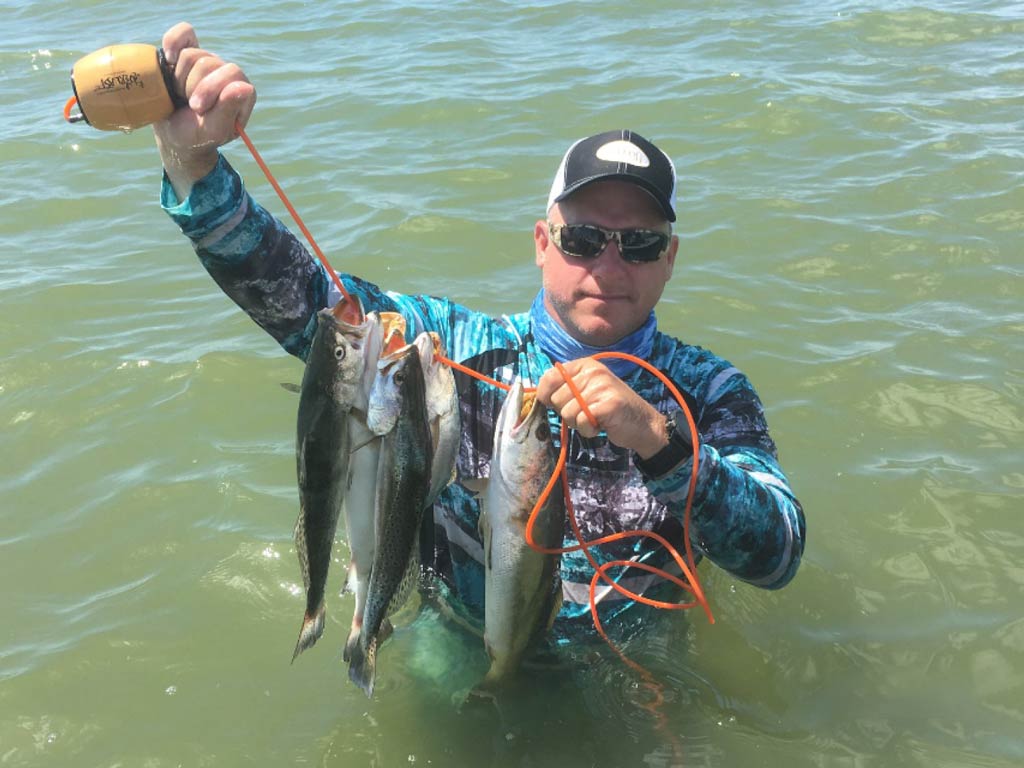
McCollum Park and Smith Point are the best for surf casting. McCollum Park is on the north side of the bay and is equipped with covered pavilions, BBQ sites, picnic areas, and restrooms. It’s also wheelchair accessible. Smith Point is at the very crossroads of Galveston and Trinity Bay and is a to-die-for location for beach surfing.
For those who aren’t afraid to get dirty and wet, we recommend wading. Wading will allow you to get up close and personal with your prey. Even though almost any corner can be prolific, it doesn’t mean that each spot is suitable for fishing. There are a lot of marshes and grounds that aren’t solid, so waders, watch your step. Apart from that, feel free to browse through the shallows and see what they have in store for you.
Where to Fish in Trinity Bay
Now that you know what angling approaches you can employ, let’s see where you can practice them. Below we’ll outline several starting points for fishing in Trinity Bay. But, truth be told, you can’t go wrong even if you randomly choose a spot to fish from. Here are our suggestions, but don’t be afraid to explore the bay on your own as well.
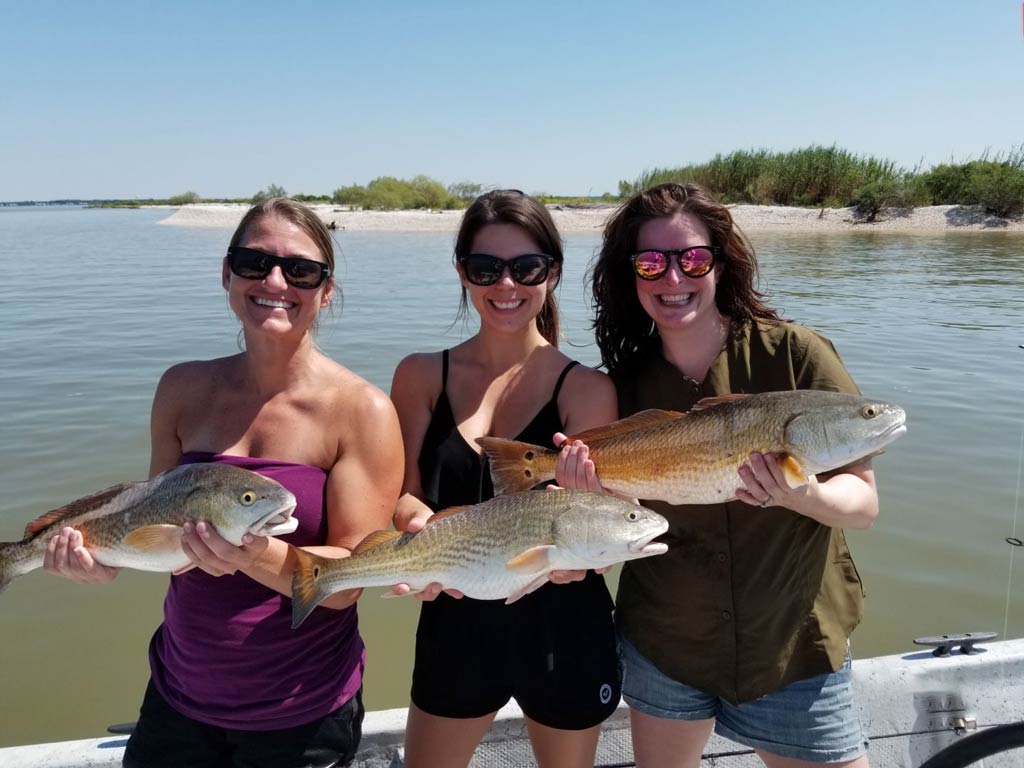
- San Leon.There isn’t a better departure point than San Leon. The main advantage of this place is its enviable location. Facing both Galveston and Trinity Bays gives San Leon a unique perspective on fishing in these waters. You’re also bound to find a charter boat that’s a match for you.
- Smith Point. Just across from San Leon lies Smith Point. This area is home to excellent boat launching sites and Robbins Park. So, you can relax and enjoy nature after a long day of fishing. Just like its, neighbor, San Leon, Smith Point comes with easy access to both Galveston and Trinity Bays.
- McCollum Park. If you’re into beautiful sunsets and surf angling opportunities, then you might want to check McCollum Park out. The park is well-maintained and fully equipped for a day out with the little ones. So, if you want to spend some quality time with your family and catch dinner as well, McCollum Park is the place to be.
- Anahuac. While it hides behind the Trinity River and it may more famous for its lake, Anahuac can be your ticket to a Trinity Bay adventure if you team up with a local charter operator. And if you’re staying in this city, on top of fishing, you’ll get the chance to find out why it’s called the “Alligator Capital of Texas”.
Frequently Asked Questions
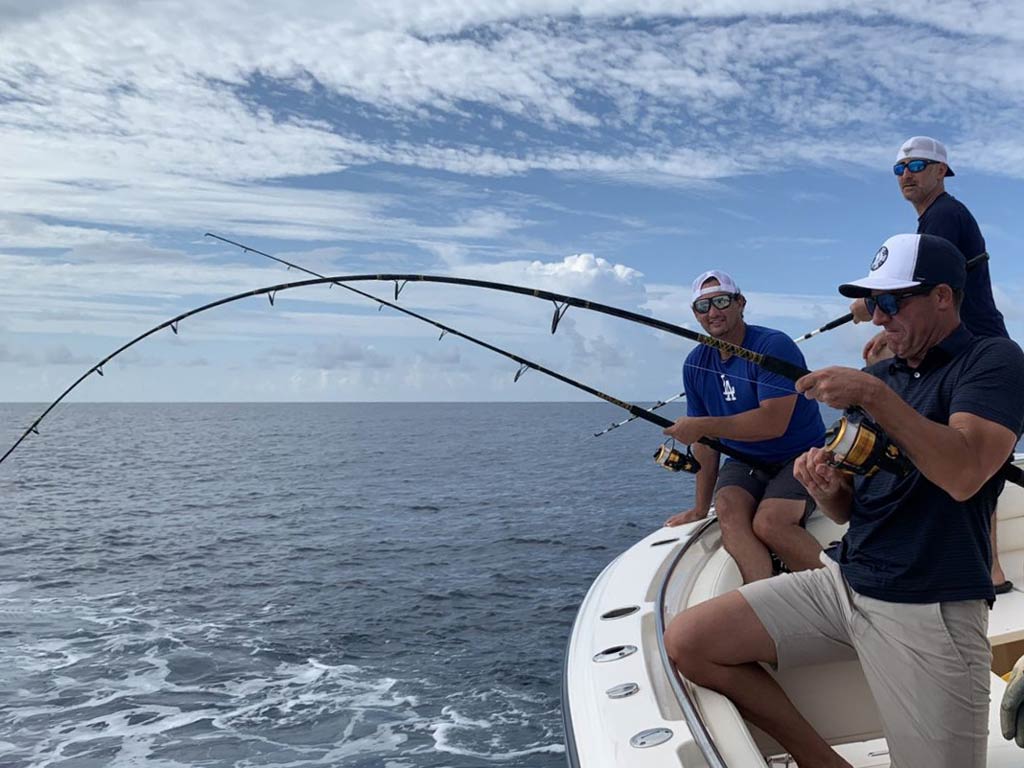
- Do I need a fishing license to fish in Trinity Bay?
If you're 17 or older, you must bring a valid Texas fishing license on your Trinity Bay fishing adventure. Make sure you purchase it ahead of time.
- Where can I buy my Trinity Bay fishing license?
You can buy it online, in a Texas Parks and Wildlife Department office, or in various retail shops. You can even order it via phone through a toll-free line.
- How much is a Trinity Bay fishing license?
Depending on your chosen package and whether you're a resident or non-resident, the price of your fishing license will vary. For a full list of available permits, visit the Texas Parks and Wildlife Department website.
- Are there bag and size limits for Redfish?
Yes. The minimum length of your Red Drum catch has to be 20 inches and you shouldn't keep more than three fish. To see restrictions for other species as well, go to the Texas PWD Bag and Length Limits page.
- What should I bring on my Trinity Bay fishing trip?
Make sure you have your fishing license, snacks, and personal items. Trinity Bay fishing charters will take care of all the rods, reels, tackle, baits, and sometimes even refreshments.
- Are Trinity Bay fishing charters kid-friendly?
Trinity Bay fishing charters welcome children aboard. Trips are geared toward exploring the calm inshore waters and they're family-friendly.
Trinity Bay Fishing: An Inshore Grand Slam Paradise
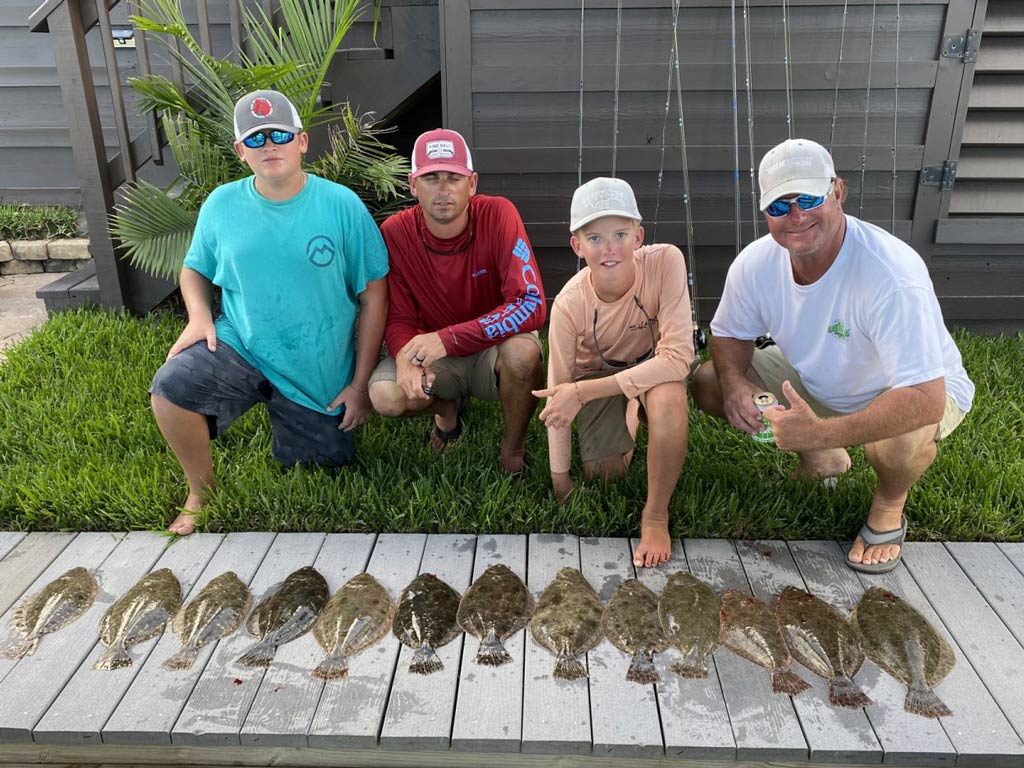
Often overshadowed by its famous neighbor, Galveston Bay, it’s Trinity Bay‘s time to shine. The region is loaded with structures that are powerful magnets for world-renowned inshore species such as Reds, Specks, and Flounders. This means that Trinity Bay is home to some prolific fishing grounds. As such, the bay is a paradise for any Inshore Grand Slam devotee. So, if you’re one a passionate inshore angler, you know where to go and what to do for your next vacation. Tight lines!
Have you ever been fishing in Trinity Bay? Did you score an Inshore Grand Slam? Any tips and tricks you’d like to share with us? Hit the button below and don’t hesitate to brag about your fishing experience or ask us anything else Trinity Bay-related.
The post Trinity Bay Fishing: The Complete Guide appeared first on FishingBooker Blog.
https://ift.tt/tpf9o7v
0 Comments
Enregistrer un commentaire